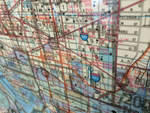Since 1869, this institution has served as both the country’s preeminent private scientific research facility and its top museum for paleontology, zoology, anthropology, and, in recent years, astronomy. It’s this constant flow of energy and insight between the research side and the curatorial side that has kept the museum fiercely vital, fresh, and unique. Just a few years ago, for example, scientists concluded that dinosaurs had not dragged their tails as had long been thought but waved them in the air as they walked. The curators responded, painstakingly dismantling the museum’s famed dino skeletons and reassembling them with tails erect. Then, in a brilliant stroke, they placed one skeleton atop a section of a Texas riverbed where they had found fossilized dino footprints (sans tail-dragging marks), giving museumgoers a peephole into how scientific theories emerge.
This double spotlight on the science itself and on how science is “made” is one of the pleasures of a visit here, with many exhibits focused on current “educated guesses” and the scientists who are making them. An extraordinarily interactive museum, it challenges visitors to figure out which theories make the most sense via computer stations, wall text, videos, soundscapes, and, of course, the artifacts themselves. That effort became even more cutting-edge in 2023, when the $431-million Richard Gilder Center for Science, Education and Innovation opened, transforming the museum-going experience. It houses 12% of the museum’s collections in a new 230,000-square-foot structure including an insectarium, a permanent butterfly vivarium, open storage exhibits showing the span of the museum’s collections, and a 360-degree-view Invisible Worlds Theater, a mesmerizing high-tech show about the networks that underlie all life (it’s hard to describe, but a real wowzer of an experience). Be sure to enter the museum through this new center: The dazzling, contemporary architecture of its lobby mimics curving Southwestern American canyons, a sinuous look created by spraying structural concrete directly onto rebar.

(Two young girls view an exhibit)
If you’re making a repeat visit to the museum, you’ll want to begin in the newer areas. But if it’s your first time, we still suggest starting your visit by exploring the dinosaur rooms on the fourth floor: The museum has the largest such collection in the world, and the hot questions surrounding dinosaurs—How did they die out? Did they care for their young? Did they live in organized herds? Are birds their descendants?—are imaginatively explored. Floors 2 and 3 are diorama-driven, with half the floors devoted to the anthropological study of various peoples of the world, the other half to African and North American mammals. If you’re short on time, take the mammal route, which features the poetic work of taxidermist/zoologist/sculptor Carl Akeley, who pioneered a new technique of sculpting papier-mâché, then covering it with actual animal skins, antlers, and hoofs, often using the animal’s bones for structure as well. The results are remarkably lifelike. (Akeley finally died in Africa while collecting animals to display.) The exhibit fulfills his mission to conserve these animals and their environment for future generations—many of the wilderness areas depicted have changed beyond recognition in the past 50 years.
Other highlights include the Hall of Ocean Life, with its famed 10-ton blue whale replica hanging from the ceiling; the Hall of Planet Earth with its humongous (and disturbing) interactive media wall about climate change; and the Spitzer Hall of Human Origins, an extraordinarily persuasive argument for the theory of evolution. The dazzling Hall of Minerals, another must-see, with its Fabergé-carved gems and the largest star sapphire in the world, reopened recently with a new design to celebrate the museum’s 150th anniversary. You’ll also want to save time for the Rose Center for Earth and Space, a monumental 120-foot-high glass box enveloping a colossal sphere, which is the virtual reality theater, the Hayden Planetarium. The planetarium’s stellar (sorry, I couldn’t resist) space show is narrated by astrophysicist Neil deGrasse Tyson, former host of PBS’s Cosmos and the director of the planetarium. When you first enter the museum, be sure to get a timed ticket to a planetarium show—they’re terrific.
Some tips for improving your visit:
- Timing: Because the museum is so popular with school groups, it’s difficult to predict when the museum will be crowded. In general, attendance is in inverse proportion to the weather: When it’s lovely outside, the crowds will be sparse within. When it’s blustery or rainy. watch out. Weekdays tend to be less crowded than weekends.
- An overview tour: First-time visitors should consider taking one of the guided introductory tours that begin at 15 minutes past the hour throughout the day. Led by highly knowledgeable and well-spoken volunteer guides (they take classes for 6 months), tours vary by guide and will often hit different highlights of the museum.
- Especially for kids: Families with children will want to visit the Discovery Room, an educational center where kids can pretend to dig up dinosaur bones, do a scavenger hunt, work with microscopes, and more. Timed tickets are given out in advance and they do run out, so get one early if you’d like to visit the Discovery Room.






 About our rating system
About our rating system


